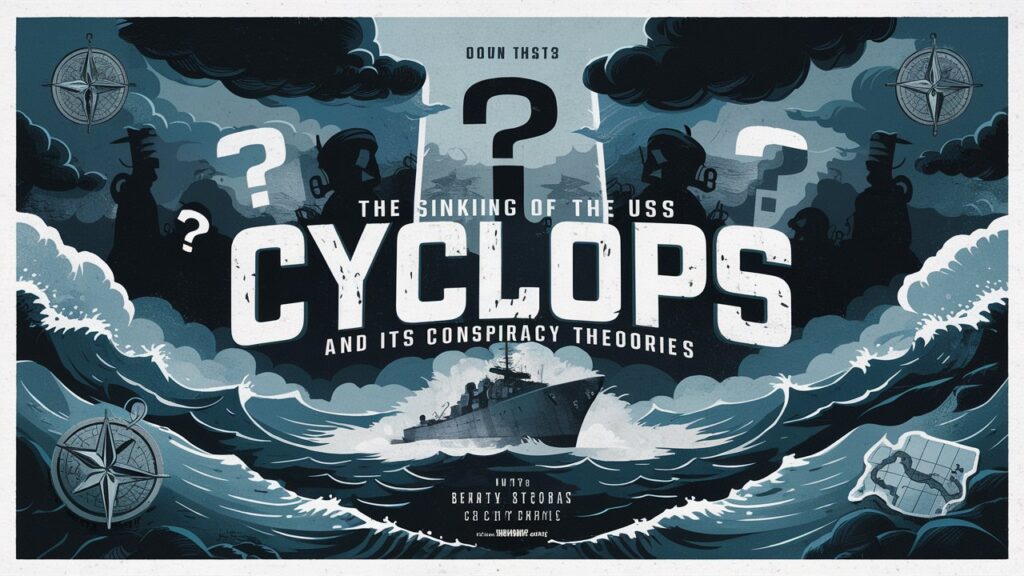The Sinking of the USS Cyclops and Its Conspiracy Theories

The disappearance of the USS Cyclops, a U.S. Navy collier ship, remains one of the most mysterious and perplexing maritime incidents in American history. Lost without a trace in 1918, the Cyclops was one of the largest ships in the U.S. Navy at the time and its disappearance sparked widespread speculation, giving rise to numerous conspiracy theories that continue to intrigue historians, scientists, and conspiracy enthusiasts alike. This article explores the circumstances surrounding the sinking of the USS Cyclops, its lasting mystery, and the various conspiracy theories that have emerged over the years.
The Disappearance of the USS Cyclops
On March 4, 1918, the USS Cyclops set sail from the island of Barbados in the Caribbean Sea, headed toward the port of Baltimore, Maryland. The ship, a 542-foot-long collier vessel, was carrying a load of manganese ore, a vital material needed for war production during World War I. The Cyclops, under the command of Captain George W. Worley, was part of a larger convoy but sailed independently.
The Cyclops was last heard from on March 10, when it radioed that it was experiencing rough weather. After that, all contact was lost. A search was launched, but no wreckage or debris was ever found. The ship and its crew of 306 men simply vanished, and it was as if the Cyclops had disappeared into thin air. Despite extensive investigations by the U.S. Navy, the cause of the Cyclops’ disappearance remains unknown to this day, making it one of the most mysterious naval disappearances in history.
The Official Investigations
In the aftermath of the disappearance, the U.S. Navy conducted an official investigation to determine what might have happened. Several theories were considered, including bad weather, navigational errors, or mechanical failure. However, no definitive evidence was ever found to explain the Cyclops’ sudden vanishing.
The Navy ruled out a torpedo attack, as there was no sign of enemy action in the area at the time. Furthermore, the Cyclops was an enormous ship, well-equipped to withstand rough conditions, leading many to question how it could simply disappear without a trace. The lack of wreckage or survivors only deepened the mystery. The case was officially marked as "unsolved" by the Navy, but over the years, the incident has sparked numerous conspiracy theories.
Theories and Conspiracy Speculations
Several conspiracy theories have emerged over the years, each offering a different explanation for the Cyclops' disappearance. These theories range from plausible to fantastical, but all share the central premise that the ship’s fate was not simply due to an accident or natural disaster.
1. The Bermuda Triangle Theory
One of the most popular conspiracy theories surrounding the Cyclops involves the infamous Bermuda Triangle, an area of the Atlantic Ocean bounded by Miami, Bermuda, and Puerto Rico, where numerous ships and aircraft have disappeared under mysterious circumstances. The theory suggests that the Cyclops fell victim to the Bermuda Triangle's purported supernatural forces.
Advocates of this theory point to the ship's sudden and unexplained disappearance as evidence of the region's mythical powers. They speculate that the Cyclops might have been sucked into a vortex or faced some other anomalous event in the area. However, no concrete evidence links the disappearance of the Cyclops to the Bermuda Triangle, and the theory remains speculative, though it has been widely circulated in popular culture.
2. Sabotage or Mutiny
Another theory posits that the sinking of the Cyclops was the result of sabotage or mutiny by members of the crew. Some have speculated that the ship's cargo, manganese ore, could have been a valuable target, leading to a potential act of sabotage for financial or political gain. The possibility of mutiny is also discussed, with some suggesting that there may have been internal tensions or grievances among the crew that led to a violent uprising or deliberate destruction of the vessel.
However, there is little concrete evidence to support this theory. The Cyclops was a military ship, and while internal unrest or sabotage cannot be entirely ruled out, the investigation found no signs of foul play or treasonous activity before the ship's disappearance. The absence of any survivors or evidence of conflict further weakens the theory.
3. Enemy Action: A German Attack
During World War I, the U.S. Navy was actively involved in patrolling the Atlantic Ocean to protect shipping lanes from German U-boat attacks. Some conspiracy theorists argue that the Cyclops may have been the victim of a German submarine attack, which was not reported at the time. According to this theory, the Cyclops could have been torpedoed, and the wreckage was either too far from shore to be discovered or was deliberately hidden by the U-boat.
The theory of a German attack is plausible given the wartime context, but there is no evidence to support the idea that the Cyclops was torpedoed. The ship's route was closely monitored, and the Navy did not receive any reports of U-boat activity in the vicinity of the Cyclops before its disappearance. Moreover, an attack would likely have resulted in some form of wreckage, debris, or survivors, none of which were found.
4. Natural Disaster: A Catastrophic Event
Another theory is that the Cyclops was simply the victim of a natural disaster, such as a sudden and violent storm or a rogue wave. The Caribbean Sea and Atlantic Ocean are known for unpredictable weather patterns, and it's possible that the ship encountered a catastrophic event that caused it to sink without a trace. This could explain the lack of wreckage or survivors, as the ship might have been damaged or destroyed beyond recognition.
While this is a plausible theory, it doesn't account for the complete absence of debris or any survivors. The Cyclops was a large and sturdy ship, and it would have been difficult for it to sink so suddenly in relatively shallow waters without leaving behind some trace of its existence. Nevertheless, a catastrophic weather event remains one of the more scientifically accepted explanations.
5. A Secret Naval Experiment
A more outlandish theory suggests that the disappearance of the Cyclops was the result of a secret naval experiment gone wrong. This theory posits that the ship may have been involved in an experimental military project, such as a new type of weapon or an advanced form of technology, and that the experiment caused the ship to vanish or be destroyed.
While this theory has no solid evidence to support it, the idea of secret experiments conducted by the military is not entirely unfounded, particularly given the classified nature of some military operations during wartime. However, the lack of any confirmed military project that could explain the Cyclops’ disappearance makes this theory speculative at best.
Conclusion
The disappearance of the USS Cyclops remains one of the greatest mysteries in naval history. Despite numerous theories and investigations, the true cause of the ship's fate is still unknown. Whether it was the victim of a natural disaster, enemy action, or some other factor, the Cyclops' disappearance continues to captivate the imagination and fuel conspiracy theories. While many of these theories lack substantial evidence, they serve as a reminder of the enduring mystery surrounding the ship’s vanishing—and the many unanswered questions about its tragic fate.



Post Comment